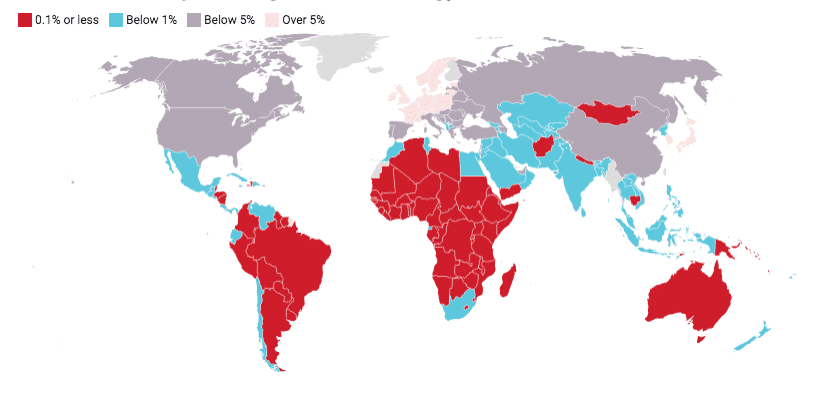Using current technology and available locations, it would be possible to capture at least 6,700 petawatt hours per annum from solar and wind, which is more than 100 times global energy demand, the Carbon Tracker Initiative said in a new report.
The decline in the cost of renewables over the past three years also means that half of this solar and wind potential is now economically viable, and by the end of the decade it will be above 90%.
“The technical and economic barriers [for renewables] have been crossed and the only impediment to change is political,” said Carbon Tracker.

Lucky country
Australia, along with Africa and South America, “stand out as having huge technical potential compared to energy demand,” the report's authors said.
“In terms of the renewable energy potential per person, Australia is in a league of its own with over 10,000 MWh per person per annum,” Carbon Tracker said. “With vast renewable potential and a low population, it is thus well positioned to become the battery of the world.”
However, the think tank noted that Australia’s geographic characteristics may not necessarily lend themselves to exports.

Due to Australia’s abundance of space, Carbon Tracker says it's unlikely that Australia (like Africa and Russia) will need to invest much in offshore wind platforms.
Solo solar?
The report also looked into the land required to power the world solely from solar PV panels. It found that 450,000 square kilometres would be needed. Carbon Tracker said the space needed to host enough solar panels to power the world is actually less than the land required for fossil fuels today, which in the United States alone is 126,000 square kilometres, or 1.3% of the country.
At wind and solar’s current growth rate of between 15% to 20%, the think tank said that fossil fuels could be pushed out of the electricity sector by the mid-2030s and out of total energy supply by 2050.

Countries in the global south are the greatest beneficiaries of the shift toward solar and wind.
“They have the largest ratio of solar and wind potential to energy demand and stand to unlock huge domestic benefits,” Carbon Tracker said. “The continent of Africa for example is a renewables superpower, with 39% of global potential.”
More specifically, countries such as Namibia have a renewables potential that is more than 1,000 times their energy demand. On the other end of the spectrum are countries like South Korea, which has a potential that is just 10 times its energy demand.

Germany is another example of a country with low potential and high demand. It has the third-lowest solar and wind resources in the world compared to its total demand. That is, Germany is not very sunny, but it is densely populated and has high energy demand. Nonetheless, it’s a global renewables leader.
“If the Germans can find solutions, then so can everyone else,” Carbon Tracker said.

This content is protected by copyright and may not be reused. If you want to cooperate with us and would like to reuse some of our content, please contact: editors@pv-magazine.com.





Shouldn’t the headline be Australia poised to be the “Generator” of the world. The article doesn’t discuss storage at all.
“Germany is another example of a country with low potential and high demand. It has the third-lowest solar and wind resources in the world compared to its total demand.”
I assume this excludes micro-countries? Singapore, Monaco, Luxembourg ….
Northern, non-Ocean countries may struggle for lack of wind and solar: Germany, Poland, Baltic States etc. They might need to import electricity and hydrogen from further south.
Hi Alex,
‘Battery of the world’ is a direct quotation of Carbon Tracker’s terms in its report. I believe they chose the word ‘battery’ to mean Australia has the potential to become an energy exporter (ie giving renewables to the rest of the world, thereby feeding out as necessary) rather than its literal meaning.
You can find more information on which countries Carbon Tracker included in its full report (https://carbontracker.org/reports/the-skys-the-limit-solar-wind/) but yes it seems like small countries were lumped into their larger regions.
I hope this clarifies things!